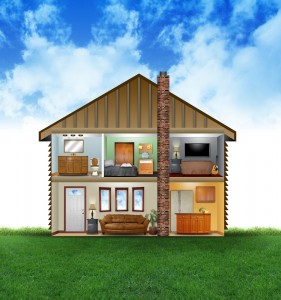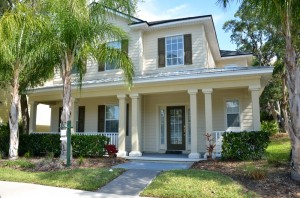 Combining a whole house fan with AC to do much of your cooling can save a lot on energy costs. It is an efficient and environmentally green strategy. In past times, we got used to throwing the previously cheap electrical energy at our cooling issues. However, times have changed and we need to explore and re-explore other options. Equipment like swamp coolers and fans have long been relegated to those who could not afford the luxury of refrigeration units such as air conditioning. However, now that energy costs have soared and the economy has tightened up, new applications and upgrades of old technologies have been brought forth. The whole house fan is such an application.
Combining a whole house fan with AC to do much of your cooling can save a lot on energy costs. It is an efficient and environmentally green strategy. In past times, we got used to throwing the previously cheap electrical energy at our cooling issues. However, times have changed and we need to explore and re-explore other options. Equipment like swamp coolers and fans have long been relegated to those who could not afford the luxury of refrigeration units such as air conditioning. However, now that energy costs have soared and the economy has tightened up, new applications and upgrades of old technologies have been brought forth. The whole house fan is such an application.
How a Whole House Fan Works
Essentially, it is a large fan unit usually placed somewhere in the ceiling in a strategic location, or a split unit with some ducting and venting that allows air to be pulled through the house, into the attic, and vented into the outside. It has two basic functions:
- Exchange of dead, hot air. It pulls cooler air from sources next to the house. By selecting where this air comes from, like shaded portions of the yard or under or next to the house, hotter inside air can be replaced with cooler air. The house therefore gets some cooling without having to refrigerate the incoming air.
- Clearing of super-heated air from the attic. Attics are often not insulated or only partially insulated, according to their location, age, design, and diligence in construction methods. Often the ceiling is insulated, but not the roof in the attic. Due to no insulation and the trapping of air in the attic, it can easily reach over 130° in even moderately hot weather.
Advantages of a Whole House Fan
- Instant cooling without large power expense.
 The initial cooling simply by replacement of heated air reduces the necessity of turning on AC and using expensive energy. It can use as little as one-tenth of the cooling cost you are used to with AC.
The initial cooling simply by replacement of heated air reduces the necessity of turning on AC and using expensive energy. It can use as little as one-tenth of the cooling cost you are used to with AC. - Reducing Attic Heat. While one would think the insulation in the ceiling would keep attic heat out of the house, this is simply not true. Quite often in older houses, ceilings are poorly insulated or not at all. In newer homes constructed under stringent codes, they are better insulated. However, in any of these, given time, heat from trapped air will tend to penetrate downward into the rooms below.
- The ducted version is quiet and has other assets. Since the motor is not directly intruding into a room of the house, it operates more quietly than the simpler ceiling version. Also, the ducting allows exchange of air to the outside without having all the interior doors open. It also allows more selectivity as to which rooms are serviced.
- Cost of installation is relatively inexpensive. It will depend, of course, on the version you opt for, the house you are installing it in, if it is a house under construction or one you have to refit to take fan and ducting, and any other logistics and labor considerations.
- Noise. They can be noisy, especially the in-ceiling version. There are some ways to limit noise such as special mountings, gaskets and multiple speed fans allowing quieter speeds during low and moderate demands.
- Dust and pollutants. Since they depend on drawing air in from outside, usually through doors and windows, it is likely you will also draw in more dust, smoke, gasses, pollen, etc. than if you had a ducted air conditioner operating.
- More rigamarole to use. With AC, you just turn it on and make sure your doors and windows to the outside are closed. With a whole house fan, you have to plan which windows and doors to open and close, depending on which side of the house you will get the best cooling from. And you may have to leave some inner doors open to maintain the best flow, and thus lose some privacy. You may also be called on to close windows once external heat had reached a high.
- Additional costs. You may end up spending more due to additional venting of the roof and beefing up ceiling insulation. There may be some buildings and spaces harder to install in than others, depending on the original construction and the availability or not of electrical lines to the area of installation.
- Variable results. Because each house has different shade available and different rooms, local and regional weather conditions, layout and other considerations, the exact cooling achieved can be variable from one house to another, one area to another and from one day to another.
How many of you have experienced having a bedroom start out cool in the evening, only to wake up in the morning to a stuffy space that is too hot and with a cottony feeling in the mouth and head? The hot air trapped above has had several hours to push the heat downward and make the rooms below untenable.
The reduction of the heated air in the attic from 130°+ to a much more moderate temperature around 85-95° takes the pressure off the AC, so it can further reduce temperatures to more comfortable levels while yet not being forced to continually compensate for the transfer of heat from the attic to the rooms below. Except in the most dire heat, you may not even need to turn on the AC.
Disadvantages of Whole House Fans
As a caveat and not to discourage anyone from them, it is only fair to mention that there are a few disadvantages.
All in all, a whole house fan can save a lot, about 90% of the AC cost in some cases. There will certainly be a great change simply due to getting rid of the super-heated attic air, and the venting of the dead air in the house. If you are really considering installing a unit in your home, call a professional and consult. Most power companies and a great many will be more than willing to give you some time towards helping you with a competent decision.
Greg Nelson
 Greg Nelson is the owner of Nelson Construction & Renovations Inc. He is a Florida State Certified Building Contractor, creating artistry in all areas of design and construction projects. He is a musician, and artist. A husband and father, Greg appreciates all the wonderful elements of family life.
Greg Nelson is the owner of Nelson Construction & Renovations Inc. He is a Florida State Certified Building Contractor, creating artistry in all areas of design and construction projects. He is a musician, and artist. A husband and father, Greg appreciates all the wonderful elements of family life.
Creative Commons Attribution: Permission is granted to repost this article in its entirety with credit to Nelson Construction and a clickable link back to this page.
"Reliable, Licensed & Insured Building Contractor"
For A NO Obligation Design Consultation
Contact Us

 Loading
Loading 





